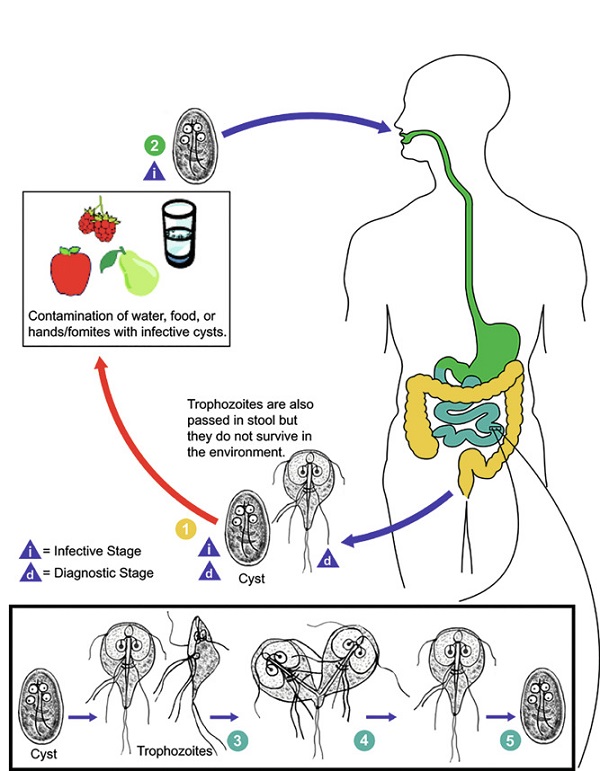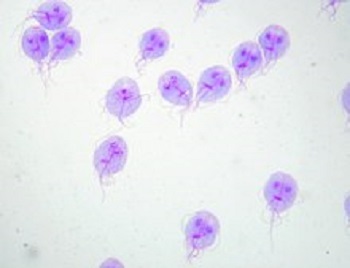Giardia intestinalis - Life Cycle, Pathogenesis, Pathology, Host Immunity, Transmission
Life Cycle of Giardia intestinalis
the life cycle of Giardia intestinalis completes in a single host
infection occurs orally by consumption of food, water, and hands contaminated with cysts
excystation occurs at pH 1.3-207 - in the stomach and duodenum where gastric acid and pancreatic enzymes such as chymotrypsin, and trypsin are produced
within 30 minutes, each cyst produces two trophozoites in the duodenum which then multiplies by finary fission (doubling time 9-12 hours) in the crypts of the duodenum and jejunum
the mannose-binding lectin present on the surface of the trophozoites and their ventral suckers adheres to the enterocytes of the host
if the Giardia intestinalis trophozoites pass down to the large intestine, they encyst in the presence of neutral pH and secondary bile salts
when encystations-specific secretory vesicles (ESVs) begin to form in the trophozoite’s cytoplasm, encystation begins which is then followed by the production of cell wall proteins
within 24 hours of the production of ESVs, the trophozoites are converted to cysts
the encystation process includes shortening of the flagella, condensation of the cytoplasm, and finally secretion of thick, hyaline cyst wall
the encysted trophozoites undergo nuclear division to produce quadri-nucleated mature cysts
these Giardia intestinalis cysts are excreted in feces, completing a life cycle

Fig: Giardia intestinalis life cycle (Source: CDC)
Pathogenesis, Pathology of Giardia intestinalis
Giardia intestinalis is a lumen dweller which causes giardiasis
they colonize the duodenum by attaching to the mucosal surface with the help of suckers but rarely invade the submucosa
the range of symptoms includes asymptomatic to diarrhea and malabsorption of fat, carbohydrates
diarrhea in giardiasis, which is chronic, occurs as
* a large number of trophozoites coats the intestinal mucosa which hinders the absorption of fats and other nutrients
* alteration in the motility of the intestinal lumen
* intestinal mucosa’s epithelial brush border is damaged
* due to increased adenyl cyclase activity in the enterocyte, secretion of fluid into the lumen is increased
in symptomatic individuals, histological abnormalities of the intestine include
* increased lymphocytic infiltration of lamina propria
* shortening or atrophy of villi resulting in disproportionate villus: crypt ratio
* sometimes the parasite penetrates the mucosal lining
Host Immunity of Giardia intestinalis
Host immunity plays a vital part in limiting and clearing Giardia intestinalis infection, reinfection, and pathogenicity. Both humoral and cell-mediated immunity are involved.
Humoral immunity
The antibodies of the humoral immune system provide protection from reinfection or newly acquired infection. Individuals with agammaglobulinemia are more susceptible to giardiasis
Cell-mediated immunity
with the help of anti-Giardia secretory IgA antibodies and specific anti-Giardia cytotoxicity, cell-mediated immunity helps to clear the parasites from the host intestine.
Epidemiology of Giardia intestinalis
Giardia intestinalis is found in temperate tropical countries with a prevalence of 2%-5% in industrialized countries and 20-30% in developing nations.

Image: G. lamblia trophozoites under microscope after Giemsa staining (Source: Wikipedia)
Reservoir, Source of Giardia intestinalis
Man is the main reservoir of Giardia intestinalis while dogs, beavers, and other animals are also possible reservoirs.
Giardia intestinalis is highly contagious. In humans, as few as 10 cysts can cause giardiasis while ingestion of more than 25 cysts has a transmission rate of 100%. Immunocompromised individuals with conditions such as AIDS and X-linked agammaglobulinemia, and protein-energy malnutrition (PEM) are more susceptible to giardiasis.
Transmission of Giardia intestinalis
Transmission of Giardia intestinalis occurs through numerous routes
Ingestion of contaminated water, food
person-to-person transmission
Ingestion of contaminated water, food
Transmission of Giardia intestinalis mostly occurs from cyst-contaminated water. Since G. lamblia cysts are resistant to chlorine, infection occurs despite routine water chlorination in developing countries. In developed nations, contaminated river and lake water consumed by hikers is the main source of transmission.
Although transmission from food is uncommon, consumption of vegetables grown where human feces are used as fertilizers, improperly washed salads, and lack of hygiene by the infected cook.
Person-to-person transmission
Transmission of Giardia intestinalis from person to person occurs in institutions such as daycare centers, nursing homes, mental asylums, prisons, and military camps where poor hygiene routinely occurs.
Sexual practices such as oral-anal and oral-genital, mostly in homosexual males can contribute to the transmission.